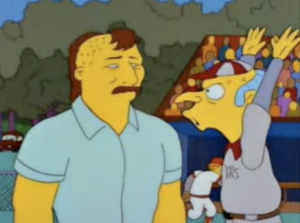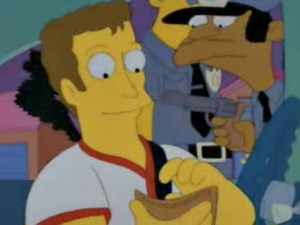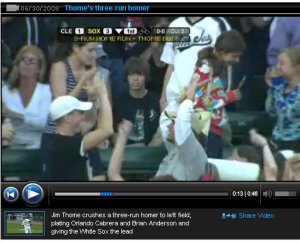When C. Montgomery Burns sent Waylon Smithers out to scour the American League, the National League, and the Negro League, a pretty solid roster was assembled for the Springfield Power Plant. But was it really the best roster that Smithers could have assembled?
Thanks to FanGraphs and Rally’s WAR database, we can see just how good of a job Smithers did. All these numbers are from the 1992 season, as the episode aired on February 20, 1992.
The verdict: the roster probably should have led Mr. Burns to release the hounds or, at least, the Robotic Richard Simmons. But just how bad was it?
Catcher: Mike Scioscia
 “Will…I…be…able…to…play…softball…tomorrow?”
“Will…I…be…able…to…play…softball…tomorrow?”
“No, Mr. Scioscia. At this time tomorrow you’ll barely be able to breathe.”
Scioscia retired after the 1992 season, a season in which he had just a .260 wOBA. Rally pegged him as a -0.9 WAR player, hardly good enough to be a mercenary on a company softball team.
And he certainly couldn’t use the radiation excuse for his dropoff in performance.
The better option for the team would have been Darren Daulton. He posted a career-high .402 wOBA with the Phillies and had a 7.4 WAR in what was easily the best year of his career.
To be fair, Daulton was coming off a -0.3 WAR 1991 season. A safer bet would have been Mickey Tettleton, who was coming of a 5.2 WAR season in 1991. However, he fell to 3.0 WAR in 1992, over four wins below Daulton.
[Wins lost: 8.3]
First base: Don Mattingly

“I thought I told you to trim those sideburns! You’re off the team! FOR GOOD!”
“…I still like him better than Steinbrenner.”
Smithers could’ve done better than Mattingly and his 2.3 WAR in 1992. Like Scioscia, a significant amount of wins were lost on this pick.
Frank Thomas should’ve been the pick at first base. His .432 wOBA was second-best in baseball in 1992 and his 7.6 WAR was stout in his third year in the majors.
Maybe it was the sideburns that drew Smithers to Mattingly.
[Wins lost: 5.3]
Second base: Steve Sax

“You just don’t know when to stop talking, do you, Saxy boy?”
What was Smithers trying to prove with Sax? That he had an eye for old, washed-up talent? Sax’ .279 wOBA was second-worst among qualified second baseman in 1992 and his -0.6 WAR nearly beat out Scioscia for worst on the team.
Ryne Sandberg and his 7.1 WAR would have been a far better choice for the team. Although I guess he wouldn’t have been a candidate to serve six consecutive life sentences for all the unsolved murders in New York.
[Wins lost: 7.7]
Shortstop: Ozzie Smith

“aaaaaaaaaahhhhh COOL!”
Finally, a semi-respectable pick. While Smith’s .339 wOBA wasn’t anything special, it was the second-best among shortstops. Obviously, Smith’s defense was his strong suit, and that pushed him to being a 4.3 WAR player in 1992.
However, Barry Larkin had a much better 1992 than Smith. Larkin’s .374 wOBA easily was the best by any shortstop and his 5.7 WAR was outstanding as well.
[Wins lost: 1.4]
Third base: Wade Boggs
 “And I say England’s greatest prime minister was Lord Palmerston!”
“And I say England’s greatest prime minister was Lord Palmerston!”
“Pitt the Elder!”
It’s tough to blame Smithers for picking Boggs, who was coming of a 6.0 WAR 1991. However, his wOBA dipped to .315 in 1992 and his WAR plummeted to just 2.2.
Robin Ventura or Gary Sheffield should’ve been the pick. Their 6.1 WARs topped third basemen in 1992. As a White Sox fan, I’ll say Smithers should’ve gone with Ventura, although seeing Sheffield get punched out for thinking Pitt the Elder was England’s greatest prime minister would’ve been pretty great.
[Wins lost: 3.9]
Right field: Jose Canseco
 “Never fear, ma’am, I’ll save your cat!”
“Never fear, ma’am, I’ll save your cat!”
Splitting time between Oakland and Texas, Canseco compiled just a 2.1 WAR in 1992. The juicehead’s defense is what brought him down, as his .357 wOBA was at least respectable.
The right pick here would have been Larry Walker, who posted a 5.8 WAR in his third full season with Montreal. While Danny Tartabull’s .397 wOBA led all right fielders, Walker’s .379 wOBA and good defense put him at the top of the right field WAR charts that year.
[Wins lost: 3.7]
Center field: Ken Griffey Jr.

“It’s like there’s a party in my mouth and everyone’s invited!”
Believe it or not, Griffey wasn’t the right pick for center field. His 5.4 WAR was nice, but there were plenty of players with better WARs in 1992.
Kirby Puckett was one, coming in at 6.7. But he wasn’t the best.
That would be Andy Van Slyke, with a 6.9 WAR. I’ll admit I was pretty surprised at that one.
[Wins lost: 1.5]
Left field: Darryl Strawberry

“Are you better than me?”
“Well, I’ve never met you before, but…yes.”
A major back injury limited Strawberry to just 43 games and a -0.3 WAR with the Dodgers in 1992. However, Strawberry regressed from a 6.5 WAR in 1990 to a 3.7 WAR in 1991, so Smithers isn’t completely exempt from criticism here.
Injury or not, the left field pick should have been obvious. Barry Bonds led baseball with a .469 wOBA and posted a 10.0 WAR in his MVP season of 1992. Those numbers were untouchable, and maybe picking Bonds would have meant it wouldn’t take a walk-off hit by pitch to beat Shelbyville.
[Wins lost: 10.3]
Pitcher: Roger Clemens

“Sir, he’s in no condition to pitch.”
Clemens had a great 1992, leading baseball with a 2.54 FIP. But, once again, Smithers strikes out with this pick.
In his final year with the Cubs, Greg Maddux posted an 8.4 WAR with a 2.58 FIP en route to winning the National League Cy Young. Plus, he’s too smart of a person to be tricked into clucking like a chicken because of some hypnotist.
[Wins lost: 0.5]
Total WAR lost: -42.6. Way to go, Smithers.



















